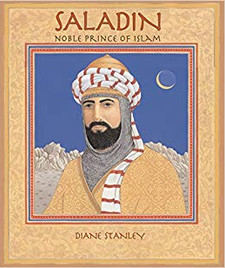A Homeschool Year in the Middle Ages
- Sarah
- Jul 21, 2019
- 4 min read
Updated: Sep 6, 2020
Growing up in public school, history class was SO boring. With so much focus on memorizing dates and names, no wonder I thought I didn't like history. Really though, history is fascinating when it is studied in the right way, with emphasis on the lives of great people and the cultures they lived in. Studying history alongside my kids has been one of my favorite parts of homeschooling, and it has allowed me to "re-write my script" from being a history-hater to now being a history enthusiast.

Last school year, my kids and I embarked upon a year-long study of Middle Ages history. I was assuming the Middle Ages would be less engaging than Ancient History, but I was totally wrong. Knights, castles, samurais, vikings, Kublai Khan, Saladin, King Arthur, Joan of Arc, Shakespeare: we actually found the Middle Ages to be uber interesting!
Although we had thoroughly enjoyed our previous year's Ancient History unit (which had included everything from history to science to music to art to food), I wanted to scale things back a bit for our Middle Ages studies. While it had been fun, the previous year's all-encompassing history studies had left me ready to have a more relaxed year for Middle Ages history.
Read-Alouds, Not Worksheets
I am a strong believer that read-alouds are far more effective than worksheets and other busy work. With read-alouds, children can easily be introduced to new ideas, cultures, and places. Most importantly, read-alouds spark some of our most important discussions, which reinforce the character lessons such as integrity, responsibility, and kindness.
Middle Ages History "Spine" Book

We used The Story of the World Volume 2: Middle Ages (by Susan Wise Bauer) as a "spine" book to provide a flowing narrative of Middle Ages history. This book tells of middle ages history in a story format, interweaving myths and legends in with the history. I loved the convenience of using the audio version of this book while we ate meals or were driving in the car.
Oodles of Supplemental Middle Ages Books
With Story of the World (SOTW) as our backbone, we read lots of engaging picture books and a few chapter books as we progressed around the Middle Ages. To give us more of a sense of the culture in the Middle Ages, I made to include folk and fairy tales books as well. I also added in a few topics/people of interest that were not included in SOTW, such as Saint Francis, the mathematician Fibonacci, and Leonardo da Vinci.
A few of our favorite supplemental Middle Ages books were:
Favorite Medieval Tales by Mary Pope Osborne
The Story of Rolf and the Viking Bow by Allen French
Kubla Khan: Emperor of Everything by Kathleen Krull
Young Arthur by Robert San Souci
Cathedral by David Macaulay
Saladin by Diane Stanley
If you want more Middle Ages book recommendations, I've put together a comprehensive booklist for the Middle Ages here. This booklist includes over 150 books, organized by age-level for elementary age, middle-school, high school, and adults. This list is made to easily correspond to chapters in Story of the World, but could also be used as a stand-alone list of books for the Middle Ages. This booklist is on-sale for only $1.99 right now as an introductory price.
Wall Map and Timeline
I've observed in the past that having visual aids hung on our walls really helps my kids learn more effectively. To this end, a large map of the world in our living room enabled me to easily incorporate geography into this unit study. We referred to this map often throughout the year.

One relatively simple visual project that my children enjoyed throughout our Middle Ages year was a wall timeline. I created a year number line using a permanent marker and Artist Tape (in my experience, this type of tape does not damage paint, even when left in-place for many months). Then, as we read about new people and places, I let my children choose whether or not they wanted to add things to the timeline.
All of the pictures were attached to the wall with Artist Tape. By the end of the year, our timeline spanned the Middle Ages and provided an interesting way to see which developments were happening around the globe at any given time.
Why Not Have Your Own Middle Ages History Unit Study?
My kids and I had so much fun exploring Middle Ages history in this way. I wanted our history unit study to be unstressed and fun, so my kids and I would thoroughly enjoy it. To that end, I made sure to never make our unit study into a "requirement". Instead, we just enjoyed reading books together, with the freedom to dive deeper on any subjects of particular interest. I made sure to read a few Middle Ages-related books on my own, too, and this gave me even more excitement and knowledge to share with my kids.
I hope this post makes you feel inspired to study history alongside your kids!
Have you had any success with unit studies in your homeschool? If so, what were your favorite features?

Links to Amazon are affiliate links. If you use these links, your price remains the same but I may earn a small commission. Thanks for supporting this site!













Comments